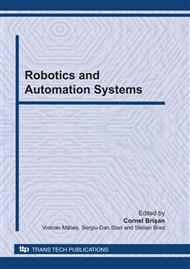p.215
p.223
p.229
p.235
p.241
p.247
p.253
p.259
p.265
Automation of Logistics Processes by Using a Universal Control
Abstract:
Due to the globalization companies are forced to implement efficient processes. Automation is a chance to reduce costs especially for repeative tasks. But by now it causes high costs for companies to integrate robots especially in case of individual systems for specific tasks. Due to the changing goods and working spaces within logistic processes automated systems have to be developed with respect to the task. The universal control computes an inverse kinematic based on application based data, executes an efficient path-planning and collision detection. This approach results in decreased develop costs for system-integrators, decreased costs for service and maintenance as less expert know-how is necessary and it results in shorter integration time, less system-failure due to the usage of standard components.
Info:
Periodical:
Pages:
241-246
Citation:
Online since:
September 2010
Authors:
Keywords:
Price:
Сopyright:
© 2010 Trans Tech Publications Ltd. All Rights Reserved
Share:
Citation:


